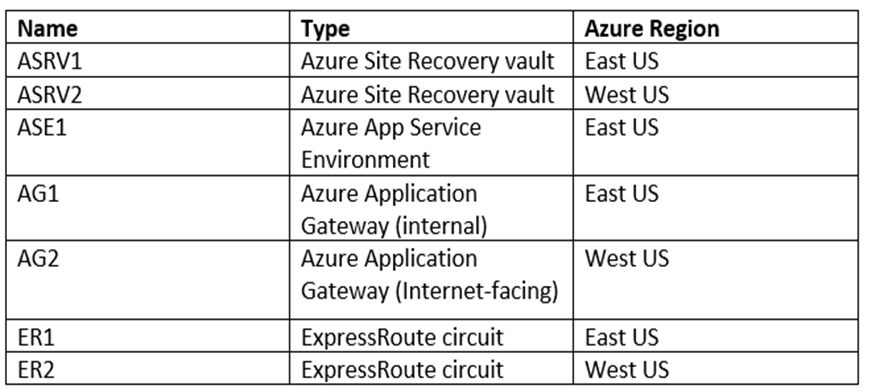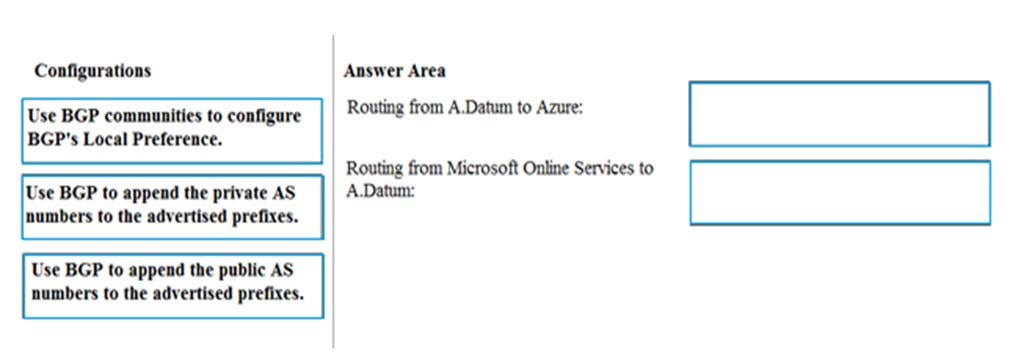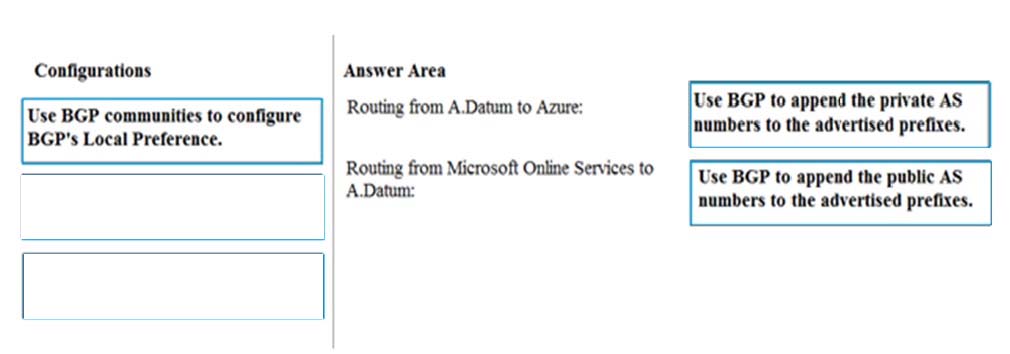Question 194 of 239 from exam AZ-300: Microsoft Azure Architect Technologies
Question
Case study -
Overview -
ADatum Corporation is a financial company that has two main offices in New York and Los Angeles. ADatum has a subsidiary named Fabrikam, Inc. that shares the Los Angeles office.
ADatum is conducting an initial deployment of Azure services to host new line-of-business applications and is preparing to migrate its existing on-premises workloads to Azure.
ADatum uses Microsoft Exchange Online for email.
Existing Environment -
On-Premises Environment -
The on-premises workloads run on virtual machines hosted in a VMware vSphere 6 infrastructure. All the virtual machines are members of an Active Directory forest named adatum.com and run Windows Server 2016.
The New York office uses an IP address space of 10.0.0.0/16. The Los Angeles office uses an IP address space of 10.10.0.0/16.
The offices connect by using a VPN provided by an ISP. Each office has one Azure ExpressRoute circuit that provides access to Azure services and Microsoft
Online Services. Routing is implemented by using Microsoft peering.
The New York office has a virtual machine named VM1 that has the vSphere console installed.
Azure Environment -
You provision the Azure infrastructure by using the Azure portal. The infrastructure contains the resources shown in the following table.

AG1 has two backend pools named Pool11 and Pool12. AG2 has two backend pools named Pool21 and Pool22.
Requirements -
Planned Changes -
ADatum plans to migrate the virtual machines from the New York office to the East US Azure region by using Azure Site Recovery.
Infrastructure Requirements -
ADatum identifies the following infrastructure requirements:
A new web app named App1 that will access third-parties for credit card processing must be deployed
A newly developed API must be implemented as an Azure function named App2. App2 will use a blob storage trigger. App2 must process new blobs immediately.
The Azure infrastructure and the on-premises infrastructure must be prepared for the migration of the VMware virtual machines to Azure.
The sizes of the Azure virtual machines that will be used to migrate the on-premises workloads must be identified.
All migrated and newly deployed Azure virtual machines must be joined to the adatum.com domain.
AG1 must load balance incoming traffic in the following manner:
1. http://corporate.adatum.com/video/* will be load balanced across Pool11
2. http://corporate.adatum.com/images/* will be load balanced across Pool12
AG2 must load balance incoming traffic in the following manner:
1. http://www.adatum.com will be load balanced across Pool21
2. http://www.fabrikam.com will be load balanced across Pool22
ER1 must route traffic between the New York office and the platform as a service (PaaS) services in the East US Azure region, as long as ER1 is available.

ER2 must route traffic between the Los Angeles office and the PaaS services in the West US region, as long as ER2 is available.
ER1 and ER2 must be configured to fail over automatically.
Application Requirements -
App2 must be able to connect directly to the private IP addresses of the Azure virtual machines. App2 will be deployed directly to an Azure virtual network.
Inbound and outbound communications to App1 must be controlled by using NSGs.
Pricing Requirements -
ADatum identifies the following pricing requirements:
The cost of App1 and App2 must be minimized.
The transactional charges of Azure Storage accounts must be minimized.
DRAG DROP -
You need to configure the Azure ExpressRoute circuits.
How should you configure Azure ExpressRoute routing? To answer, drag the appropriate configurations to the correct locations. Each configuration may be used once, more than once, or not at all. You may need to drag the split bar between panes or scroll to view content.
NOTE: Each correct selection is worth one point.
Select and Place:

Introductory Info
Question
Explanations

Azure compute services, namely virtual machines (IaaS) and cloud services (PaaS), that are deployed within a virtual network can be connected through the private peering domain. The private peering domain is considered to be a trusted extension of your core network into Microsoft Azure.
Services such as Azure Storage, SQL databases, and Websites are offered on public IP addresses. You can privately connect to services hosted on public IP addresses, including VIPs of your cloud services, through the public peering routing domain. You can connect the public peering domain to your DMZ and connect to all Azure services on their public IP addresses from your WAN without having to connect through the internet.
https://docs.microsoft.com/en-us/azure/expressroute/expressroute-circuit-peerings